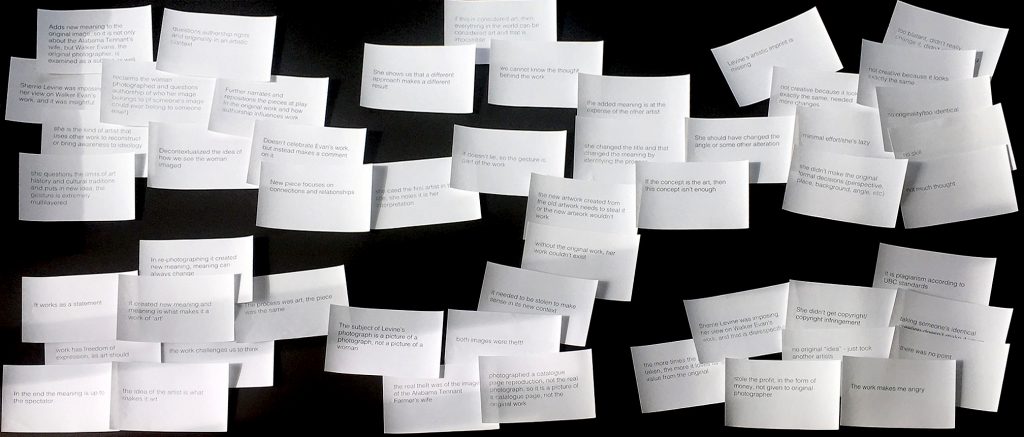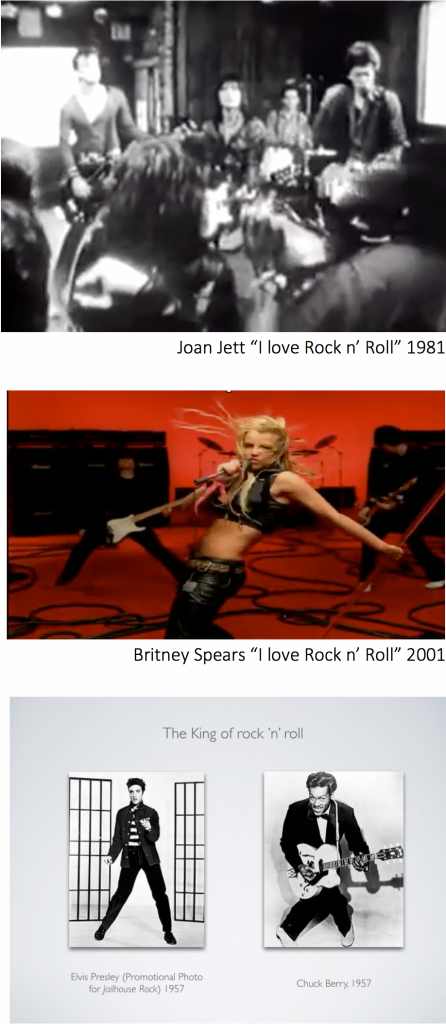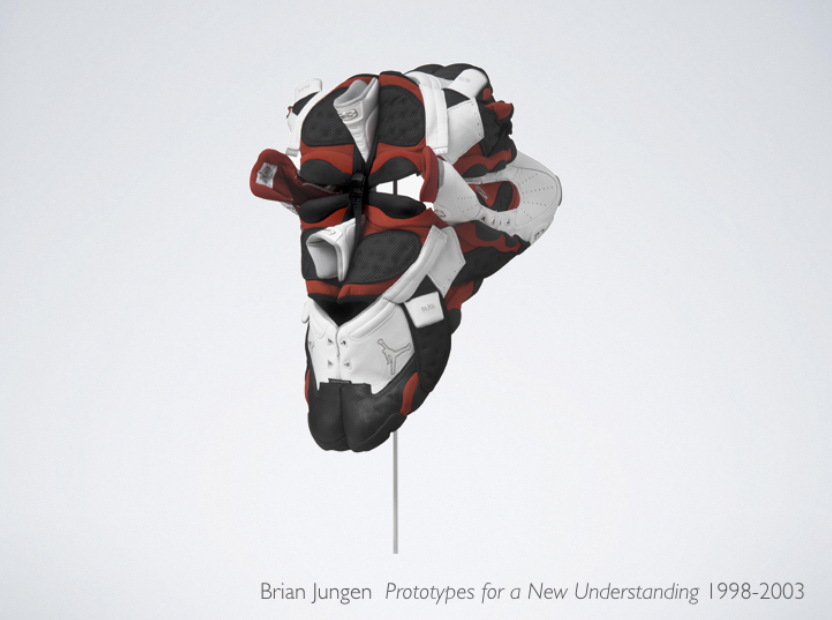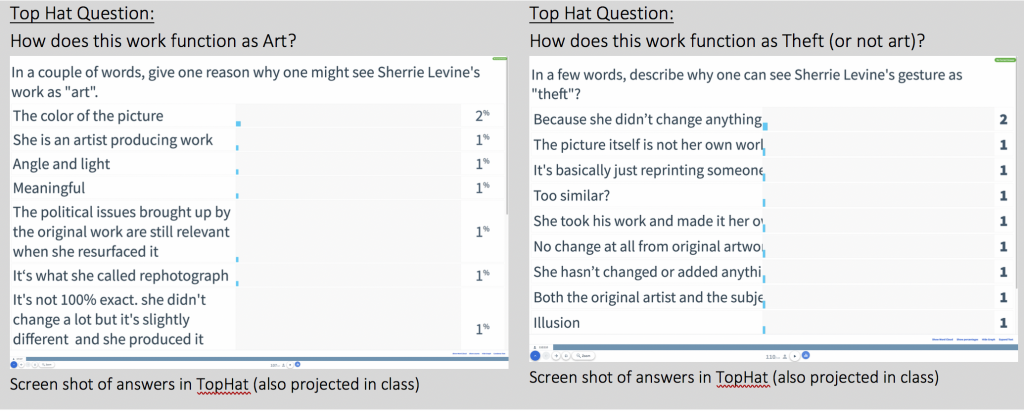Lecture using TopHat response System, Linking to Lab
| Around the seventh week of the VISA 110 Large Foundation Digital Media studio class is the start of the final unit on Appropriation techniques in digital visual arts. The one-hour lecture introduces them to the idea of appropriation. I start the lesson via visual culture, by presenting students with “I love Rock n’ Roll” by Joan Jett. I open up a dialogue with the class asking them what the piece stands for in culture.
Some points I direct students to think about:
I soon follow up with a clip of the remake by Britney Spears. Students then asked to dissect how this represents culture and societal values of the time, and what it does with the ‘meaning’ from Joan’s. Questions to pose:
|
I then go on to inform them that the Joan Jett version was a remake of the Arrows, and that Rock n’ Roll was known as an image and sound stolen from African American culture. |
The lecture then explains Appropriation through definition and significant keywords:
- “the use of borrowed elements in the creation of a new work” “the taking over, into a work of art, of a real object or even an existing work of art” (Tate Dictionary)
- To take possession of another’s material, often without permission, reusing it in a context which differs from its original context, most often in order to examine issues concerning originality – or to reveal meaning not previously seen in the original.
- originality – what is originality? Is it a quality that can refer to the circumstances of creation? Is it about ‘invention’ by the author? Is originality a property of the author, or the work itself?
| Top Hat Question: At this point I ask students to pull out their phones, and answer a small poll about if they believe in “originality” –does it exist? |
- authorship – one who originates or gives existence to a piece of work. Authorship then, determines a responsibility for what is created by that author. Appropriation makes us question the idea of authorship altogether. This can be extended to ownership.
- recontextualization – puts whatever it borrows into a new context in order to create new work, this can change the meaning of the work.
- Death of the Author – Roland Barthes, 1967, from language to visual, slides below.
I then present an overview of art historical antecedents of appropriation to the present, featuring:
- Pablo Picasso Guitar 1913
- Hannah Hoch Cut with the Kitchen Knife 1919
- Marcel Duchamp Fountain 1917
- Bruce Nauman Self‐Portrait as a Fountain 1967‐70
- Sherrie Levine Fountain (After Marcel Duchamp: A.P.) 1991
- Andy Warhol Soup Cans 1960s
- Brian Jungen Prototypes for a New Understanding 1998-2003
- Walker Evans Alabama Tenant Farmer’s Wife 1936
- Sherrie Levine After Walker Evans 1981
Walker Evans’ work of Allie Mae Burroughs, an Alabama farmer tenants’ wife from 1936, depicts an ambiguous face of how one can depict poverty in the American south during the depression. Levine, hijacks the discussion from how we can subject people to images and ideas, acting as representations, to ideas of authorship and what it means to make an image, representation, thus idea. Appropriation changes the way we dissect the image because we must bring in previous meaning to understand new meaning. I ask students to give a reason why the image could be seen as ‘theft’ as well as come up with a way it could be seen as ‘art’.
Top Hat Screen Shot:
- Michael Mandiberg Untitled (AfterSherrieLevine.com/2.jpg)2001
I end on a screen shot of Michael Mandiberg’s AfterSherrieLevine.com site where his “scanned” version of Sherrie’s version of Evan’s is circulated virtually for everyone to download, bringing yet another element to the appropriation of the work. The conversations from the lecture connect and continue in the smaller labs, run by Teaching Assistants, (please see next page).
Active Learning Activity in Lab, Follow-up with Responses from Lecture
I select approximately 50 of the most interesting and diverse student answers from the TopHat activity from the previous lecture, and print them out on index cards. The cards are available in the lab classroom, where Teaching Assistants facilitate a debate of the various answers. The following is the lesson plan provided online (https://blogs.ubc.ca/visa110/) for the TA’s for first half of the class that week. A fully realizing map image is provided on the next page.
March 13 Lab Appropriation – Workshop Outcomes:
- Enact a critical outlook as visual readers, recognizing how meaning is cultivated and perpetuated through representation.
- Produce ethical, informed, multi-dimensional, work that is situated in contemporary concerns.
- Identify the characteristics of medium towards the interpretation of an image, in order to make informed material choices for their own work.
Appropriation Workshop 1 – Debate Map Lesson Plan for TA’s
(50 minutes)
- Please have students continue from the first appropriation in-lecture activity, continuing the debate of Sherrie Levine’s work. You will be provided with a series of responses on index cards that comprise interesting answers from TopHat by students in the class, (these will be passed on from teacher to teacher as there is only one set!) there will be some empty index cards for students who wish to add more responses to the debate of Sherrie Levine’s Art vs. Theft. Leave the students’ additions in the pack for the next class, and let us see where this goes.
- Have students arrange a “debate map” with the different answers either on the white board (with magnets) or flat on tables lined at the side of the room. Have them order the various answers in a way that makes the divide between “Art” and “Theft” (and everything in-between or even both sides!) towards the creation of a skeleton of reasoning. If they wish to add in more labels, such as “both” or “neither” or anything else that may come up
- On blank index cards, have them fill in areas or add points that would complete the map that seem to be missing, if they haven’t already done so.
- By the end, go over some of the answers which ultimately give evidence of our values and how they reside in art-making. You may want to ask them to place themselves on an area on the map, or to pick up a card that most represents how they feel about the work.
- In particular, in our contemporary day is skill the main indicator of a work of art work or artist? Does an artist sometimes have to take a wrong step (stealing) in the right direction (questioning authorship and expertise/authority) in order to bring out larger issues? How does a retelling or appropriation use the initial agency of the work in its new meaning? (This question is vital as for the most part the appropriation projects become music video’s or trailers and lack any uncovering of how the initial footage projected particular ideologies, and how appropriation can expose these and break them down, rather than perpetuate them). You may also want to question if the theft makes them angry, could that affect not be considered art? If they show that they prefer the answer “there was no point” question if there really wasn’t any idea or if they just didn’t like the idea, or if they are somewhat focused on originality you can question if the gesture of re-authoring the work was not original? Etc
- This technique was inspired be Derek Bruff’s use of debate maps, visit Derek Bruff’s Agile Learning Blog for more information.
- A ‘ping’ (I must learn how to do this?) has indicated to Derek that I’ve used his method as per this explanation, and a complimentary analysis of my use of debate maps has been written by Dr. Bruff, to read please click here. Thank you Derek!

Sample of an ordered debate map of the various readings of Sherrie Levine’s work.






